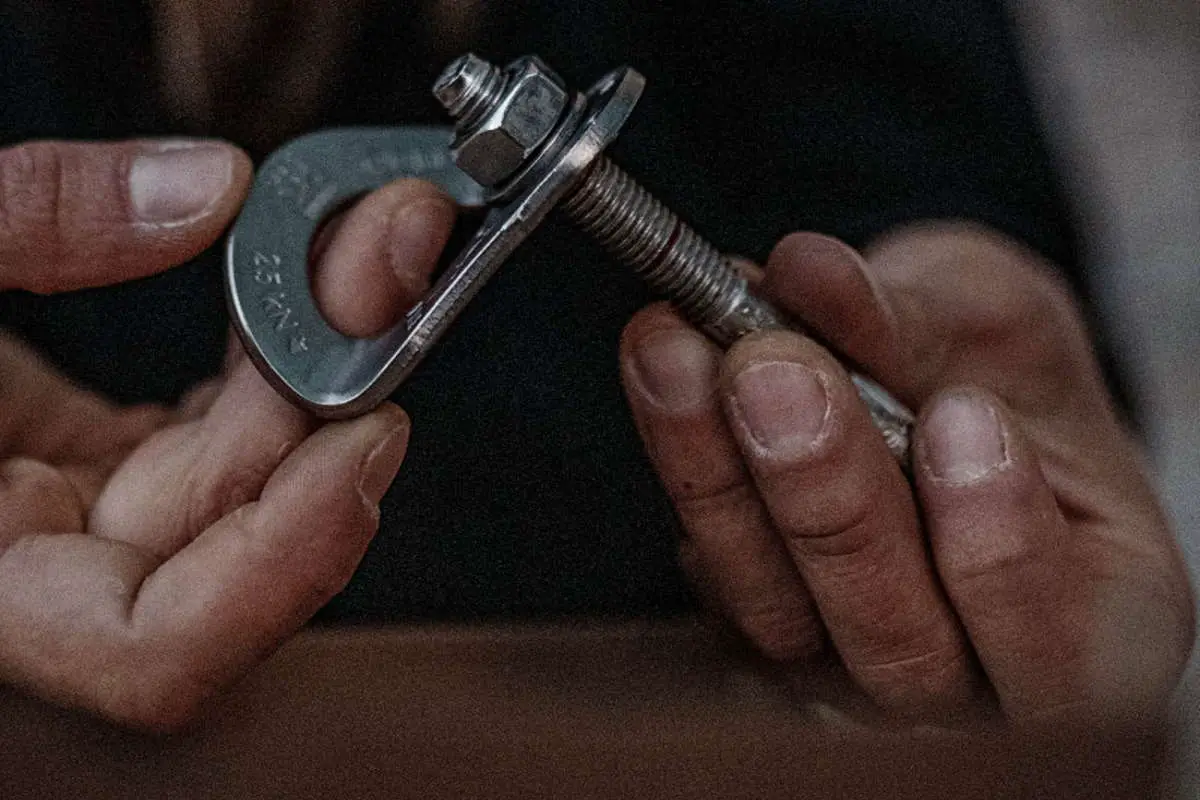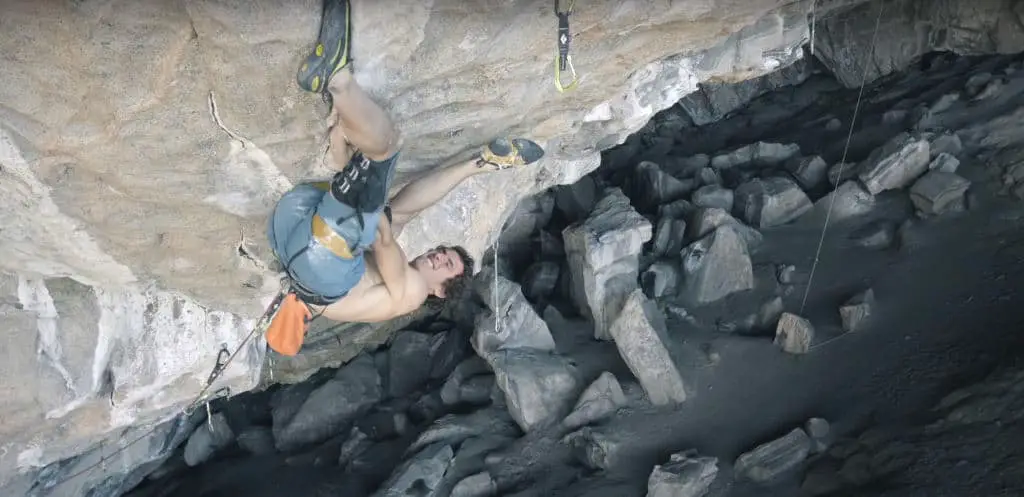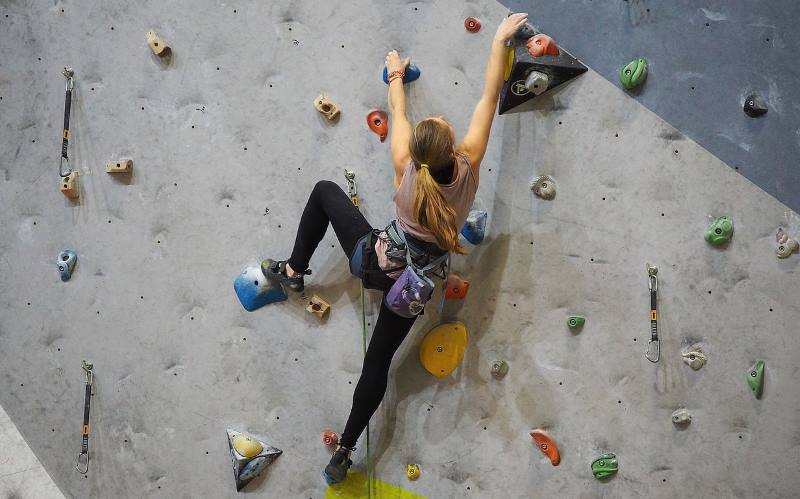If you’ve been watching Sport Climbing at the Olympics and are eager to learn – you’re at the right place. Find out how to start rock climbing today with our top tips and easy guide for climbing newbies!
How To Start Rock Climbing?
Nowadays rock climbing has become much easier to get into with the rising popularity of indoor climbing gyms. Learning to climb indoors give you a safer way to learn the ropes (literally) and means you’ll be much more confident when you get out onto real rock.
You can learn to roped climb indoors but another popular form of rock climbing is Bouldering. This goes to about four meters from the floor at max, you don’t need ropes, and thick crash matting covers the floor. It’s a great way of getting more climbing in per session as well as climbing alone.
We’d always recommend that you learn to rock climb indoors first. Follow these simple steps to start climbing today!
Step 1 – Find Your Local Gym
Our absolute best advice to start climbing is to find your local climbing online and book a taster course. Some gyms have a mix of roped climbing and bouldering and give you a chance to test out both. This course should just be about trying out climbing for the fun of it without much instruction.
You don’t need to bring any gear, be super fit, or have tried climbing before to do these. Just turn up with clothes you can move around in and be ready to try hard!
Step 2 – Choose Your Own Adventure
If you enjoyed the taster – great! From here you can carry on bouldering without much else to learn. Just make sure you are practicing your falls without good technique and always climbing down when you can. If you were more into the roped side then it’s time to book a course.
Learning to top rope is the intro to all roped climbing. Top roping classes normally take two or three sessions and most gyms allow you to hire their gear once you’ve passed. Keep getting comfortable on the ropes and with your belay technique and you’ll find progression comes naturally.

Step 3 – Find A Crew
One of the best parts of climbing is the friendly community. Sharing beta, giving encouragement, and team work are all big parts of the climbing world. Finding a great climbing partner or a solid crew to share cool experiences with can be really rewarding.
We suggest chatting to people (without spraying unwanted advice), getting involved in local climbing clubs, or joining local facebook climbing groups looking for a partner. Many gyms also have a social climb night where you can meet up with others who are generally fairly new.
Step 4 – Dial In Your Technique
In your first few months of climbing, you’ll get better just by climbing more. You don’t have to worry about outside strength training as you’ll naturally start to exercise the right muscles – plus your finger tendons – from getting a couple of sessions a week.
The biggest improvements you’ll see are from simple technique improvements. Our personal top tips for better basic climbing technique are: –
- Use Your Toes – Less foot on the hold feels less secure but allows more movement. If just your toes are on the hold you can pivot left and right as well as drop your heel down, push up for a jump, or get a couple of inches extra reach.
- Arms Straight – You should only bend your arms when you are actively pulling your body up to the next hold. Once you grab a hold, sit down and straighten your arms. With straight arms you can rest your arm muscles.
- Keep Your Body Close + Low – Our center of weight is generally our hips and lower trunk. Keep your hips close in to the wall and low. This stops your from pulling your body up with arms bent when you don’t need to. Having your body out from the wall also adds force pushing you backwards, making holds feel worse.
- Push With Your Legs – Most people have way stronger legs than arms. Use this to your advantage by starting a movement upwards by pushing from bent legs to fully straight. See how much difference it makes to saving arm strength and gaining height!
- Twist! – Try and move the shoulder of the arm that is going to reach up next closer to that side by twisting your body from one side to the other. Basically twist on the wall to get closer to where you are going next. Try just pointing your toes both one way (and therefore your hips and body to the opposite side) along a route and see how it works.
Step 5 – Get The Gear
The main piece of gear we’d suggest for newbies is a decent pair of climbing shoes fitted to you. Our general advice is to try hire shoes for about a month to get used to how tight they should be, then try on a few pairs at a shop. The simple advice is to make sure climbing shoes are snug but fit your foot shape.
For the rest of the gear you can probably get away with just hire stuff for a while. A cool chalk bag and decent chalk always makes climbing feel a bit more like its “your thing”. Once you’re ready to get your own stuff take a look at at the following articles for a full rundown.
Our Picks For The Best Beginner Gear
– Best Beginner Climbing Shoes – Best Beginner Climbing Harness
– Best Beginner Climbing Belay Device – Best Beginner Climbing Rope – Best Beginner Bouldering Crash Pad – What Is An Air Traffic Controller In Climbing?
Step 6 – Venture Out
Keep up the stoke by trying climbing outdoors. Hire a guide and take a group of friends out to try real rock and see what it’s all about. A guide will allow you to get out there without worrying to much about safety. You’ll often learn a lot about how much footwork matters when there aren’t colored holds to rely on.
If you liked the experience we think now is a great opportunity to think about how important the outdoors is. If you want to start climbing outdoors you’ll need to learn not just the skills but the responsibility that comes with climbing. We have to take care of the land we have so others can enjoy it for the future too.

Step 6 – Learn To Lead
Lead climbing is the step up from top roping and what you’ll need to be able to do to sport climb outdoors. It ramps up the fear factor a little as falls get bigger and require a little more planning – but it’s not as dangerous as it might look.
The best way to learn to lead is to do an indoor course at your local gym. This normally takes a couple of sessions and should be followed by a couple of months of regular practice. Learning to give a great belay and to take falls are skills that need to be worked on regularly throughout your climbing career.
From here you can then either do a course on indoor-to-outdoors skills at a gym or by hiring an outdoors guide. Getting out by yourself is then an amazing activity and can take you all around the world or even just to local areas you’d never thought existed.
Step 7 – Branch Out!
From here the world is your oyster! If you enjoying leading and want to do some wilder climbs then try learning trad climbing (traditional) where you don’t have bolts and need to place your own gear. Maybe get out on some big mountain hikes and use those new balance and scrambling skills to scope out future routes – though always be prepared for emergencies.
Going for a camping and bouldering trip can be a great way to hang with your friends and do a group activity. You can also travel the world or your country to visit amazing climbing spots. Learning to climb is much more than just the skills, it’s about the experience that the natural world can give us.
We really encourage you to try something new – even if it’s a little scary at first. Climbing has changed a lot of lives and broadened many horizons. We hope it gives you as much as it has given us.
How Much Does It Cost To Start Climbing?
Beginner sessions normally cost around $20-30 to try rock climbing. You don’t need any gear, just turn up at a session and you’ll get gear hire included. Wear loose fitting or gym clothes so you can stretch and move about.
If you’d like to learn climbing you can normally get a course of two or three sessions that takes you through roped climbing, belaying safely (holding a climber’s rope) and some basic skills. REWORD
If you just want to try Bouldering most gyms allow you to turn up, watch a video, and try it yourself for around $20 including shoe hire. We’d recommend booking a Bouldering introduction where an instructor will show you how to Boulder and fall safely, as well as teaching you some basic technique. REWORD
| Session | Average Cost |
| Roped Climbing Taster | $20-30 |
| Roped Climbing Course | $50-60 |
| Bouldering Introduction | $30-40 |
| Normal Session Price | $15-25 |
You don’t need shoes, rope, or any specific clothes to start. Most equipment can be hired at the gym and if you decide to continue then we’ve got some great guides to help with buying beginner gear. For Bouldering you just need shoes. For top roping the ropes are already hung, you’ll need a harness, belay device and carabiner too.
Read What To Wear Rock Climbing?
Is Rock Climbing Hard For Beginners?
Rock Climbing seems really hard people if you’ve never tried it before. It can feel intimidating seeing the stunts some people pull with seemingly no effort. The beauty of climbing is that’s it not about how hard you climb, it’s about what you get from it.
Alex Lowe famously said “The best climber is the one having the most fun“. As long as you are enjoying yourself and pushing your limits that’s all that matters. It’s definitely a challenge but beginners improve really rapidly in only a few sessions. Coming back to a route you really struggled on one week and flashing it the next is a great feeling!
Don’t avoid climbing because it seems hard. Challenge yourself and you’ll find climbing can be an amazing experience!
Do You Need Upper Body Strength To Start Climbing?
No, you don’t need massive arms, abs, or any real strength to start climbing. It helps but that’ll come naturally as you progress. The biggest thing that will help as a beginner is learning good technique. Learn to keep your arms straight and push with your legs rather than pull with your arms is the first step.
Rock Climbing Health + Fitness
Can You Lose Weight Rock Climbing?
Is Rock Climbing A Good Workout?
Rock Climbing Benefits – Physical + Mental Health
Can You Start Climbing Alone?
Yes, if you’d prefer to climb alone or can’t rope a buddy there are a couple of easy ways to start. You can Boulder without needing anyone on the ropes. It’s a great way to learn to climb and you might find Bouldering is your perfect activity.
If you’d like to rope climb ask the gym about booking onto a course and learning with a mixed group. There are plenty of like-minded people who want to do the same and you might find a new climbing buddy on the course.
Most gyms also have a regular club for people without a climbing buddy to partner with. They’re a great way of getting in to the climbing community to find people you’re comfortable climbing with. Often you’ll then find people who climb outdoors so you can try that out too.
Read the full article – Can You Rock Climb Alone?
Can You Start Climbing At 30 / 40 / 50+?
Yes! There are levels of climbing that suit everyone and you’ll find a challenge no matter your age. Find a god partner you can trust and work at your own pace. If you are worried about your knees, hips, e.t.c then consider roped climbing over bouldering as there isn’t as much impact.
Bouldering involves falling onto matting but it’s more common to get injured than on roped climbing. For roped climbing you can use top ropes where falling is just a foot or so and generally very safe. Scuffs, scrapes, and bruises happen but as long as your partner is belaying safely you should be fine.
Climbing is much safer than people imagine. We always recommend starting indoors because we can limit the objective hazards and set routes for all levels. When you start to lead climb and go outdoors that’s when you have to start assessing risks and deciding where your comfort level lies.
Can You Teach Yourself Rock Climbing?
While you can improve your technique and basic skills once you’ve learned them, we don’t recommend teaching yourself any of the safety skills. While YouTube videos, articles, and books are good tools for backing up already learnt skills we think that hands on teaching is always best.
Working with an instructor means you get things that might be missed out, can ask questions to clarify things, and get taught the why rather than just how. Climbing skills are often not always one-size-fits-all and some skills are safe ins some situations and dangerous in others.
How Often Should You Climb As A Beginner?
Climbing twice a week is perfect sweet spot to start with. Gives yourself at least one day between sessions and at this pace you’ll progress steadily with less risk of injury. Three times a week is definitely doable as long as you pay attention to your body, take rest when you need, and space out sessions.
More than this and you’re much more likely to pick up an overuse injury or make a dangerous mistake from not concentrating. Take your time when you’re new, listen and learn from others, and try to enjoy it for what it is.



